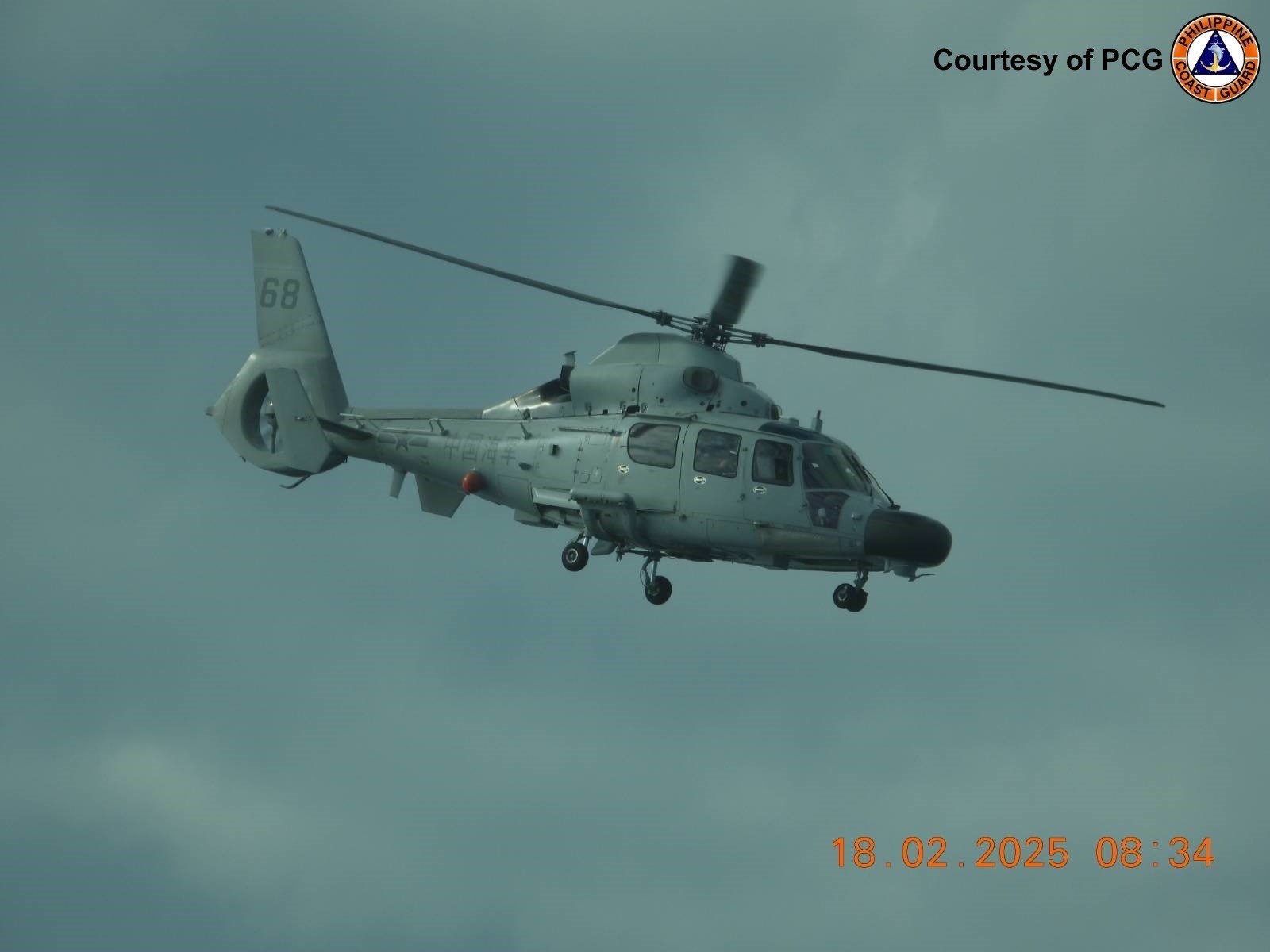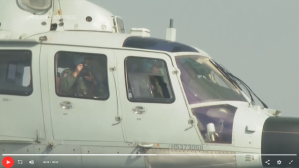In yet another ‘blatant’ display of Chinese military aggression, a People’s Liberation Army (PLA) Navy Z-9 utility helicopter flew dangerously close—within 3 meters (10 feet)—of a Philippine Bureau of Fisheries and Aquatic Resources (BFAR) aircraft over the territorial waters of Bajo de Masinloc (Scarborough Shoal).
Philippine Coast Guard (PCG) spokesperson Jay Tarriela stated that on the morning of February 18, a BFAR Cessna turboprop aircraft, with journalists and Philippine Coast Guard (PCG) officers on board, was conducting a maritime domain awareness (MDA) flight in the area.
However, approximately 90 minutes into the flight, a People’s Liberation Army Navy (PLAN) helicopter appeared on the horizon, closing in on the BFAR aircraft.
Tarriela added, “Around 0839 hours, a People’s Liberation Army Navy (PLA-Navy) helicopter, identified by tail number 68, performed dangerous flight maneuvers towards the BFAR aircraft.”
The Philippine pilot radioed a warning to the Chinese navy helicopter, stating that it was flying too close and endangering the lives of the crew and passengers.

“Keep away and distance your aircraft from us, you are violating the safety standard set by FAA and ICAO,” the pilot urged. The spokesperson emphasized that this careless maneuver endangered the safety of both the pilots and passengers during the MDA flight.
The helicopter was estimated to have approached within approximately 10 feet of the aircraft’s port side, just above the wing.
The incident raises “significant concerns regarding the PLA-Navy’s clear violation and blatant disregard for the International Civil Aviation Organization’s (ICAO) international aviation regulations.”
Foreign journalists aboard the plane witnessed the tense 30-minute standoff as the Philippine aircraft maintained its low-altitude patrol over Scarborough Shoal, a reef formation in the South China Sea. The Philippine aircraft showed no indication of deviating from its planned route or altitude to prevent a collision.
While onboard the Philippine aircraft, a photographer from Agence France-Presse documented the encounter by capturing footage of a Chinese helicopter crew member directing a camera at the BFAR Cessna.

This incident occurred just days after Australia condemned Beijing for “unsafe” military actions, alleging that a Chinese Shenyang J-16 fighter jet deployed flares within 30 meters of an Australian Poseidon surveillance aircraft conducting patrols over the South China Sea.
Meanwhile, in response to the latest aerial encounter, the Chinese Embassy in Manila accused the Philippine aircraft of unlawfully entering what it described as “China’s airspace” without authorization.
It confirmed that China’s military deployed naval and air assets to track, monitor, and “drive away” the Philippine plane.
Chinese military spokesperson Tian Junli, as reported by Xinhua, China’s state news agency, reiterated that the Philippine aircraft had entered Chinese airspace without approval, framing the incident as an unauthorized intrusion.
The ambassador of the United States, a defense treaty ally of the Philipines, slammed the Chinese helicopter’s “dangerous” maneuvers. In a post on X, Ambassador MaryKay Carlson also called on China “to refrain from coercive actions and settle its differences peacefully in accordance with international law.”
China’s Harbin Z-9 Helicopter
The Harbin Z-9, also known by its NATO reporting name “Haitun,” is a Chinese military utility helicopter produced by Harbin Aircraft Manufacturing Corporation.
It is based on the French Eurocopter AS365 Dauphin, with adaptations made for various roles, such as transport, air support, reconnaissance, security, ambulance, anti-submarine warfare, search and rescue, and more. Each side of its fuselage has a pylon designed for attaching a single pod or missile rack.
The first flight of the Z-9 took place in 1981. It was built using components from Aérospatiale as part of a production license agreement signed on October 15, 1980.
By January 1992, the indigenous Z-9B variant, incorporating 70% locally produced parts, successfully took flight. It entered production in 1993 and became operational with the People’s Liberation Army (PLA) by 1994.
The Z-9B features a more advanced 11-blade Fenestron tail rotor and composite blades, replacing the 13-blade tail rotor of the original AS365N.

The Z-9 can carry up to 10 fully armed soldiers. While the Z-9 is similar to the AS365N Dauphin in many aspects, later models incorporated more composite materials to improve structural strength and reduce radar visibility.
Powered by two turboshaft engines, the Z-9’s design includes a four-blade main rotor and a teardrop-shaped fuselage. In 2002, a new H410A variant was introduced, which uses more powerful Turbomeca Arriel 2C engines.
After the original license agreement expired, Eurocopter initially objected to the continued production of the Z-9. However, the dispute was eventually resolved through international negotiations, and the French company later resumed cooperation.
The Z-9 helicopter has multiple variants designed for various military and civilian roles. Beijing has exported Z-9 helicopters to over 10 countries, including Bolivia, Cambodia, Kenya, Mali, Pakistan, and Zambia.
According to the OE Data Integration Network (ODIN), a US Army digital resource for the Worldwide Equipment Guide, the Z-9 is too lightly protected to be classified as an “attack helicopter,” despite claims from some sources.
- Contact the author at ashishmichel(at)gmail.com
- Follow EurAsian Times on Google News




